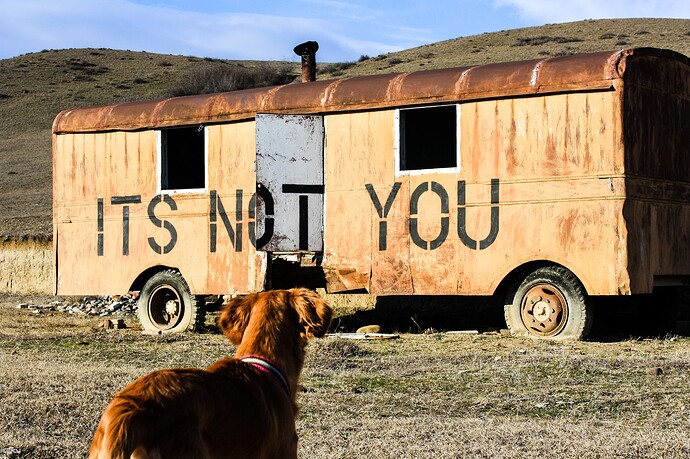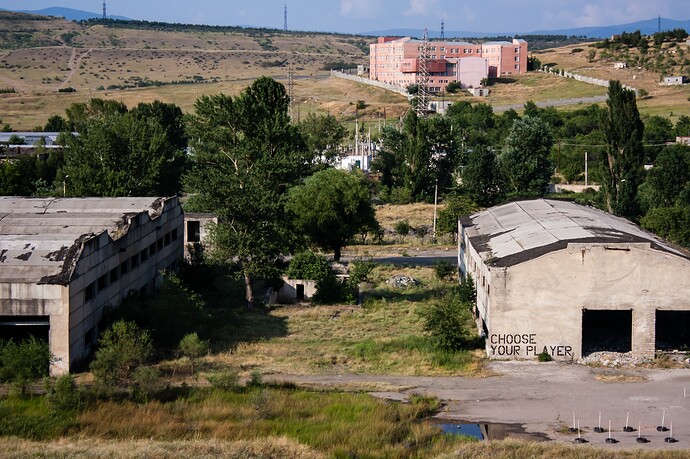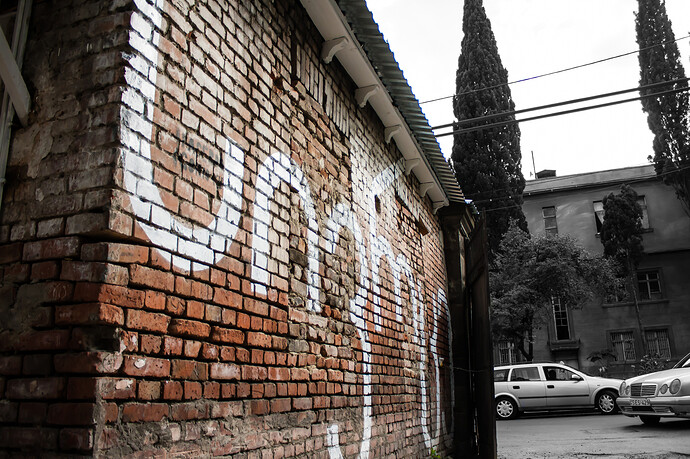George and I just moved to the outskirts of Tbilisi. We decided to take the dogs out for a hike in the hills behind our new apartment. It was a very windy, cold day. But the environment was amazing: long stretches of yellow fields, small bushes, some cows wandering around here and there, and mostly nothingness. The bliss of silence and emptiness. Away from urban structures.
And that’s when we saw it. On a trailer. In the middle of nowhere.
“It’s not you.”
A few weeks later we walked in down town. Without the dogs. With a visiting friend. We did our usual tourist walk. And while we passed the Georgian Orthodox Patriarch’s house, George noticed something on the pavement.
25.000.000. The amount the church receives from the Georgian government.
Not long after we noticed a billboard on a central square. DRO, it said, in bold black letters. Time. That is what it means. And every day, thousands of cars would pass it. On top of a building, in the heart of the center.
It definitely got us talking. And our friends. And our neighbors. And our relatives. And our co-workers.
The whole city had seen texts appearing on buildings, trailers, garages, billboards. Questioning the urban space we live in, questioning the society we live in.
Meet Mariam Natroshvili and Detu Jincharadze, the artists behind it all. Since 2011 @sadarismelia work together.
They work in two directions: text based art, interventions in public spaces; and ghost museums, site specific installations inspired by different stories, knowledge and mythology.
I started doing this kind of work, because I wanted to start a conversation, I want to question things happening in society. To change it maybe. But I don’t have any illusions, I just want to start the conversation. Artists should always ask questions, not answer it.
First, when we started, it was much more linked to urban problems, and architecture. Abandoned buildings, soviet stye buildings: creating a new language of the city. And that is what urban art is for me, creating a new language. Language of the people that can not talk or are invisible. That is one of the reasons that we are making spaces talk. Literally.
The first thing we made was a poem by Carlo Kacharava. He’s a poet and writer from the 1990s and we put his critical poem on a wall. We wanted to make the city a book and use contemporary not very popular writers. But we only made one. It was too difficult as it was too much work.
Mariam explains me how she believes in art without bureaucracy and without permissions. Art should be outside of galleries and museums. Art should instigate change, it should question and provoke. A perfect example is the 25.000.000 project.
It was a reaction, a question. Me and young artists Gvantsa Jishkariani made this stencil in front of the patriarchs residency on his birthday. This is the amount which the church gets from the government every year. In a country where social and economical problems are severe, the government pays 25 million to an organization which speaks a language of hate and threatens people with hell. The Organization which organized a violent mob of thousands of people against 50 activists trying to raise awareness over LGBTQ rights.
The main idea of this text was to question this. And then, what should we do? Should we cancel it? When should we cancel this agreement? Or, what they did in Germany, where they opened the archives and you can find who was KGB.
Those were main results which I wanted to see.
We had problems with the police and the patriarch’s security after this project. The text was made on the pavement and legally the police couldn’t fine us. But together with patriarch’s security in the police department they tried to threaten us so that we wouldn’t ask any questions again.
We got a lot of messages, a lot of people were upset. It was unimaginable to them. But the conversation has to continue, it started, but I don’t think it continued.
Mariam and Detu use urban spaces to start a dialogue. Project Hyper Text Transfer Protocol is about the language of forgotten, abandoned places. Places which are not on the map any more. The trailer George and I saw on our hike in the hills is part of this project. They use ready-made messages from internet, social media, different programs or websites and bring them into a different context. It re-creates its initial meaning and transforms the text into content that is multiple and flexible, subjective and personal.
Project Homework is a series of word paintings. Each word functions as a symbol that represents a concept. The meaning of the word-symbol depends on viewers and the context it is presented in. The perception of the word is subjective and depends on each person’s individual association with the word. It plays with public’s consciousness, its ideas and associations. Remembering forgotten meanings and words. The word DRO on a billboard in the city center is part of this project. Mariam tells me how she asked different people at different times what they thought of it and the best answer she got from a taxi driver.
He said that former president Misha Saakahvili was about to make a speech for new year on the video screen where our text was now. Then prime minister and Sakashvili’s archenemy Bidzina Ivanishvili did not allow it and he burned it down. As a result, Saakashvili was angry and wrote DRO on the billboard. And that’s what I like. Our work doesn’t have any author, my connection to the text ends when we make it.
Right now they are working on projects related to forgotten knowledge.
We are creating the museum of superstition, The Batumi Backyard Stories, collecting all the knowledge of the people living there. It is more ethnographical or anthropological kind of research, and then we translate it to visual and artistic language. We are continuing the ghosts museum project in Garikula. We are collecting stories from the people in the area, from the villages, and translating it to visual language. But is more informative, it should have an informative outcome. It is kind of subjective. It is knowledge and lifestyle of people what is disappearing. The legends, and how this influences the people living there.
At the moment we are trying to get funding for projects which are directly connected to urban development and architecture. One of the projects is called Re-thinking the city. It is focused on different periods of city development. The project is based on research of soviet and post soviet architecture and divides history of the city in six different periods and themes. We want to realize artistic interventions in different districts of Tbilisi. Exhibitions, workshops and seminars are planned within the project. The project will last about one year and will have, besides the artistic, also an educational function.
As the city is in crisis in present, and the future is also undefined, it is exactly now that we need to re-think, decontextualize and reload the city for future development.
Our works/projects are connected to the soviet past and the inevitability of rethinking this past for future development. After the fall of the Soviet Union, Georgia never had time to think and plan a future. Most political and social processes have been based on emotional, impulsive decisions. In such an environment, development is impossible.
The Soviet ideology is not gone, it is partly replaced by other ideologies and power. This is well visible in architecture and art.
Mariam and Detu work together. But they don't have a schedule. Inspiration comes and goes.
We don’t have systematized working schedules. Sometimes its spontaneous, but if there’s a deadline it’s much more organized. Sometimes when I wake up, ideas like come to my mind, but often it just develops and shapes throughout the course of a year.
We need to do research and get inspiration: thinking, drinking. But sometimes when I drink I can’t work.
The thing that I hate most is paperwork. You need to do this to get funding or to go somewhere, but I am not an accountant, I can’t enjoy it.
And to fund bigger projects is quite difficult. When I worked at the school of at the Center of Contemporary Art, we had to make final exhibition of students. The funding was only 300 Gel (120 euros). I suggested to go to casino with this money and gamble together with students. If we would win, we would make an exhibition focused on money and funding in art. If we would lose, we would still make a show: presenting the video which we would get from casino, how we lost the exhibition money. Unfortunately I couldn’t do it in the end, but maybe I will do it once. Why? To start the discussion on how to survive as an artist and that only way for getting funding for exhibition of young artists is to gamble.
But, for the projects we do in streets (artistic, not curatorial projects as homework or http projects) we don’t need funding. Most of the time we fund our work ourselves.
Unfortunately, it is money that makes a lot of projects happen. But lack of funding is not the only reason projects sometimes fail.
The experience that I have is that most of the people don’t take their work serious here. It’s more like having fun, rather than working and thinking theoretically.
And that is why we are so fucked up in Georgia I think.
Also, engagement is an issue. We have participated in some workshops and projects which were on urban space, on the transformation of urban spaces. The most important part of urban art is engagement of the local communities. And I have not seen that yet. But maybe in Georgia we don’t have experience in that yet.
The most problematic thing for me is that organizations are finding funding and just doing it for the sake of I don’t know what. It doesn’t have impact for me, no visible impact.
Mariam and Detu work together with other groups: movements and NGOs that believe in similar causes.
Last January we tried a collaboration of groups working in urban problematics: Guerrilla Gardening, Iare Pekhit, Tiflis Hamkari, and some other groups. The first try failed. Now are only four or five organizations left that decided to work together.
But I don’t know. It is sometimes impossible to work together. Someone always has different ideas or different thoughts, and discussion doesn’t exist here. Everybody just goes with their direction and doesn’t want to share the ideas. Maybe also, you know, it is an issue of time, experience. It may also be fear. It is often a communication problem.
But when you are struggling and you have the same aim, you have to leave your ego behind. We can have a different background, different ideas, when you have a difficult situation as we have here in Georgia now, in every field, why should you not collaborate and work together?
After the flood in Tbilisi on the 13th of June we have once more discovered that government and city hall are totally impotent and its time to take initiative in our own hands. Its time to change, its time to act.
And although engagement of civil society is really poor in Georgia, we together with other activists decided to start a new movement which wont ask people to gather in front of city hall but to act.
We are trying to focus on different problematic issues as: domination of cars, unsafe city, uncontrolled investments and new buildings, lack of green spaces.
We already started to give some examples how to reclaim the city: we have blocked one of the sidewalks with flower pots made out of tires. Parking on sidewalks in Tbilisi is allowed, so to walk in street especially with children or for old people becomes more and more dangerous as cars are sometimes even driving really fast(on sidewalks!) sometimes sidewalks are just blocked with cars and one has to cross the street or walk over the cars. So we made a video instruction: how easy it is to occupy sidewalk. Officers tires were moved after one day and plants were through away. But video was shared in Facebook hundred times and other people made the same in different streets.
We are also marking different places with stencils: here once was public pool or here once was a market. On places where instead of different public spaces now monster buildings are build.
In September, in one of the problematic areas of the city, the former hippodrome, we are planning a big event. We call it ideas laboratory, ideas fair Conquer the city. This will be a kind of exhibition. An open call will be announced and students, artists, architects, urbanists or stay-at-home moms and dads, anybody who thinks that city needs help, will be invited to present their ideas on platform. For example, one person wants to make a garden on a garage in front of his block but doesn’t have funding or just needs help. He/she can bring the visualized idea to fair where we also invite different funds and companies. We want to help people realize those projects. To start change from small scale. To create a different form of resistance. To reclaim the city. And yep, we have to start from our street, or yard, or block.
We have to act, we have to change.





